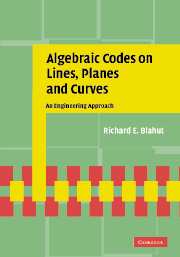Book contents
- Frontmatter
- Contents
- List of figures
- List of tables
- Preface
- Dedication
- 1 Sequences and the One-Dimensional Fourier Transform
- 2 The Fourier Transform and Cyclic Codes
- 3 The Many Decoding Algorithms for Reed–Solomon Codes
- 4 Within or Beyond the Packing Radius
- 5 Arrays and the Two-Dimensional Fourier Transform
- 6 The Fourier Transform and Bicyclic Codes
- 7 Arrays and the Algebra of Bivariate Polynomials
- 8 Computation of Minimal Bases
- 9 Curves, Surfaces, and Vector Spaces
- 10 Codes on Curves and Surfaces
- 11 Other Representations of Codes on Curves
- 12 The Many Decoding Algorithms for Codes on Curves
- Bibliography
- Index
6 - The Fourier Transform and Bicyclic Codes
Published online by Cambridge University Press: 05 October 2009
- Frontmatter
- Contents
- List of figures
- List of tables
- Preface
- Dedication
- 1 Sequences and the One-Dimensional Fourier Transform
- 2 The Fourier Transform and Cyclic Codes
- 3 The Many Decoding Algorithms for Reed–Solomon Codes
- 4 Within or Beyond the Packing Radius
- 5 Arrays and the Two-Dimensional Fourier Transform
- 6 The Fourier Transform and Bicyclic Codes
- 7 Arrays and the Algebra of Bivariate Polynomials
- 8 Computation of Minimal Bases
- 9 Curves, Surfaces, and Vector Spaces
- 10 Codes on Curves and Surfaces
- 11 Other Representations of Codes on Curves
- 12 The Many Decoding Algorithms for Codes on Curves
- Bibliography
- Index
Summary
Given the field F, the vector space Fn exists for every positive integer n, and a linear code of blocklength n is defined as any vector subspace of Fn. Subspaces of dimension k exist in Fn for every integer k ≤ n. In fact, very many subspaces of dimension k exist. Each subspace has a minimum Hamming weight, defined as the smallest Hamming weight of any nonzero vector in that subspace. We are interested in those subspaces of dimension k over GF(q) for which the minimum Hamming weight is large.
In the study of Fn and its subspaces, there is no essential restriction on n. This remark is true in the finite field GF(q) just as in any other field. However, in the finite field, it is often useful to index components of the vector space GF(q)n by the elements of the field GF(q), when n = q, or by the nonzero elements of the field GF(q), when n = q − 1. The technique of using the elements of GF(q) to index the components of the vector over GF(q) is closely related both to the notion of a cyclic code and to polynomial evaluation. The essential idea of using nonzero field elements as indices can be extended to blocklength n = (q−1)2 by indexing the components of the vector υ by pairs of nonzero elements of GF(q). Then the vector υ is displayed more naturally as a two-dimensional array.
- Type
- Chapter
- Information
- Algebraic Codes on Lines, Planes, and CurvesAn Engineering Approach, pp. 247 - 276Publisher: Cambridge University PressPrint publication year: 2008



